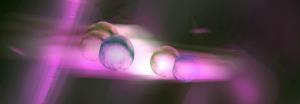The magic cocktail of deuterium and tritium
Nuclear fusion in stars is easy: it just happens, because the immense gravity of a star easily overcomes the resistance of nuclei to come together and fuse. But making nuclear fusion happen here on Earth is incredibly difficult, so it makes sense that you would choose the easiest of all the very hard options available to you. That explains why most fusion research today is focused on the magic cocktail of deuterium and tritium.
To understand why, we need to take a closer look at the recipe for this particular cocktail, with a sprinkling of protons, electrons and neutrons, a dash of quantum mechanics, and a sense of where chemical elements most want to go.
American Scott Willms—who spent 25 years working at the Los Alamos National Laboratory before coming to ITER in 2011 and who has been ITER's Fuel Cycle Division Leader for the past seven years—puts it quite simply. "Everything in the universe aspires to be iron—so light things fuse and heavy things split to move toward the middle of the periodic table (i.e., iron). At the light end of the scale, deuterium and tritium are the furthest away from iron, so they have the greatest aspirations."
When hydrogen nuclei fuse to produce helium and give off energy, the remaining potential energy is lower than it was when they were separate. Add another proton, and two or three neutrons, and you get lithium, and more energy emitted—and this continues as you add protons and neutrons, until you reach iron. In the other direction (nuclear fission) you get energy emitted by splitting atoms apart, all the way from uranium (the heaviest element found in any appreciable amount in nature) to iron (the most stable).
"The main problem when you want to fuse nuclei is that they have the same electric charge, so they naturally repel each other," says Alberto Loarte, Head of ITER's Science Division. "It therefore makes sense to choose a pair of nuclei with the lowest electrical charge, as this represents the smallest barrier the nuclei need to overcome to fuse. Hydrogen nuclei contain only one proton, so, of all atomic nuclei, they have the smallest barrier to overcome."
Hydrogen is the perfect fuel, but it turns out that the cocktail recipe for fusion improves when you use isotopic variants, with additional neutrons compared to normal hydrogen—which is why scientists have determined on deuterium, which has one extra neutron, and tritium, which has two.
One of the problems with creating nuclear fusion is that there is no absolute certainty for any reaction attempt that the nuclear reaction will occur at all. "In nuclear physics or in quantum mechanics, you only have a probability," says Loarte, "and you want to increase that probability as much as possible." The probability of a fusion reaction happening is called the cross-section. "It's a bit like a billiards table, but in three dimensions—the probability that one atom will hit another is calculated by 'quantum geometry'; the cross-section is the likelihood that the cue ball will hit the billiard ball."
The cross-section varies with temperature. And it turns out that deuterium and tritium have the greatest cross-section at the lowest temperature of any possible fuel candidates—making them the perfect cocktail ingredients for a fusion reaction. In addition, the plasma temperatures required for net energy release are already attainable, and the energy yield of the reactions is high, at 17.6 MeV for the basic DT fusion reaction.
"All of this is doable, every parameter has been achieved," says Loarte. "Although we haven't put everything together all at once before to make a practical reactor with net production of energy."
The cocktail shaker which will make it all happen is of course the tokamak vessel. Just as the ingredients to mix a drink need to be shaken together, energy—lots of energy—needs to be added to the fuel mix to get fusion going. In ITER's case, in order to overcome the repelling electrical charges of the particles, the plasma needs to reach a temperature between 10 and 20 times hotter than the centre of the Sun—so while the Sun's core burns at a 'mere' 15 million degrees Kelvin, scientists will need at least 150 million degrees Kelvin at ITER.
Only at this extreme heat and contained under intense pressure from the magnetic fields, will the particles race towards each other and fuse, releasing energy. The reaction produces charged alpha particles, which are contained within the cocktail shaker by the magnetic force and contribute to further heating of the plasma. It also produces uncharged neutrons, which escape.
This is key. "The neutrons, which can't be contained by the magnetic field, escape, providing the heat which will eventually be harnessed in future power stations," explains Loarte. "Unfortunately, it also means that the material in the reactor wall gradually gets degraded by the high energy neutron impact."
While other fuels could, in theory, be used, they would require even higher temperatures. Deuterium-deuterium fusion reactions would need plasma heated to 400-500 million degrees Kelvin, while boron, another potential fuel, has four protons, so it takes four times as much energy as the DT reaction to overcome its repulsive force (or, some 600 million degrees Kelvin).
For the time being, scientists at ITER—and other fusion experiments around the world—are working with deuterium and tritium as the magic ingredients in this extraordinary cocktail.
But look back at how much extraordinary progress has been made in fusion research over the past 90-odd years, since Ernest Rutherford's decisive 1934 experiment that realized the fusion of deuterium into helium—and paved the way to the work being undertaken at ITER today.
So who knows where scientific research, new technical abilities and giant technological leaps might lead us over the next 90 years, in finding new or different cocktail ingredients?


